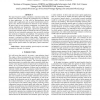Free Online Productivity Tools
i2Speak
i2Symbol
i2OCR
iTex2Img
iWeb2Print
iWeb2Shot
i2Type
iPdf2Split
iPdf2Merge
i2Bopomofo
i2Arabic
i2Style
i2Image
i2PDF
iLatex2Rtf
Sci2ools
81
Voted
ICASSP
2009
IEEE
2009
IEEE
Chirp rate estimation of speech based on a time-varying quasi-harmonic model
The speech signal is usually considered as stationary during short analysis time intervals. Though this assumption may be sufficient in some applications, it is not valid for high-resolution speech analysis and in applications such as speech transformation and objective voice function assessment for detection of voice disorders. In speech, there are non stationary components, for instance timevarying amplitudes and frequencies, which may change quickly over short time intervals. In this paper, a previously suggested timevarying quasi-harmonic model is extended in order or to estimate the chirp rate for each sinusoidal component, thus successfully tracking fast variations in frequency and amplitude. The parameters of the model are estimated through linear Least Squares and the model accuracy is evaluated on synthetic chirp signals. Experiments on speech signals indicate that the new model is able to efficiently estimate the signal component chirp rates, providing means to develop more ...
| Added | 17 Aug 2010 |
| Updated | 17 Aug 2010 |
| Type | Conference |
| Year | 2009 |
| Where | ICASSP |
| Authors | Yannis Pantazis, Olivier Rosec, Yannis Stylianou |
Comments (0)

